Away in a slit trench
Posted: 25 December 2008 23:19
I spent Christmas morning up on the Downs discovering yet another slit trench; nothing remarkable in light of recent discoveries, but it did reveal useful construction data.
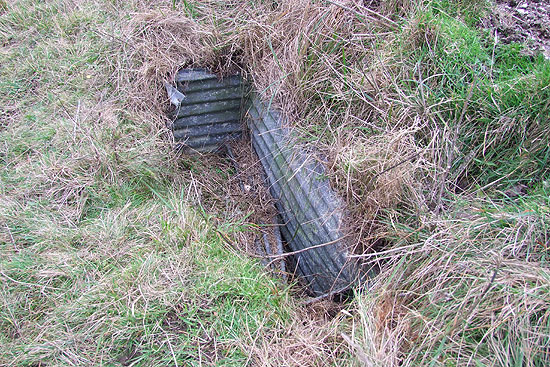
My main family get-together isn't until Boxing Day, so I decided to get a quick trip in while the home front was quiet.
One thing that has been puzzling me is the arrangement of the corrugated iron revetment in all these trenches and today I learnt a lot. The problem is that most have partly collapsed in or been backfilled, making it hard to see how they were actually constructed.
Venturing into an area I've walked through several times previously I noticed a 'new' trench plain for all to see; another discovery due to low vegetation.
I spent a few minutes making sure I hadn't already recorded it, due to its close proximity to others I've already mapped. One reason I immediately thought it was new was the fact that it was comparitively intact and 'get-inable', which most others are not.
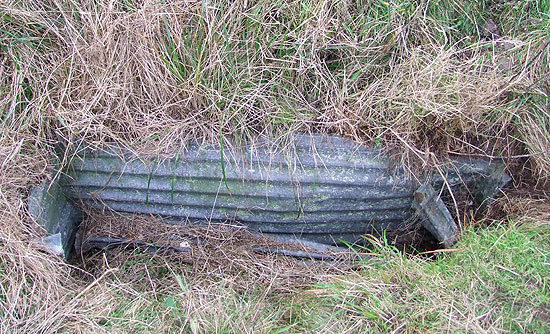
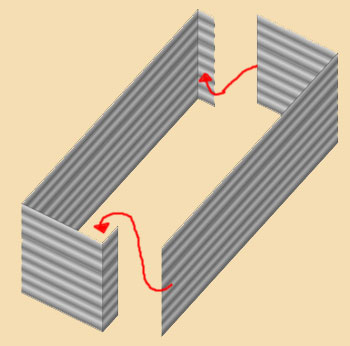
The Sketchup model at right shows the corrugated iron revetment; I had previously wondered whether the sheets were cut to size for each wall, but it would appear that just two folded sheets could cover all four sides.
The sheet at left is the rear wall of the trench; it's simply one sheet that has been folded in three places to cover one end, the back wall with the corners of the other two sides turned with small flaps to overlap the front wall.
The front wall of this trench had caved in and was now forming a partial floor with a layer of earth and chalk on top, but I assume it was originally as the other panel seen at right.
One question that still needs an answer is that of trench depth; this one appeared to be 70cm deep (the height of the iron sheet) but other trenches seem to be about 90cm deep. I have also seen some instances of two overlapping sheets seemingly being used to extend the depth - I need to go back and have a closer look.
The photo below shows the junction of the side wall with the right rear corner with its 'flap'. The arrow shows how the end wall and this flap originally met up.
Another interesting feature of this trench was a couple of pieces of chicken wire that were present; one piece is ringed below.
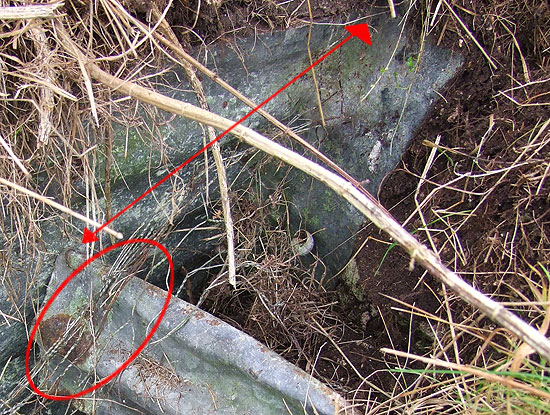
This chicken wire has been seen in at least one other trench and my theory is that it was packed with vegetation and used as overhead camouflage; I think I've seen references to this in a war diary - something else to check up on.
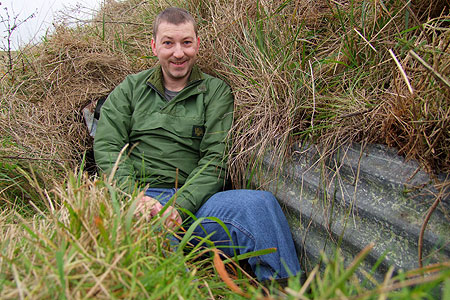
Sitting in the trench was actually beneficial, as it provided some useful cover from a cold breeze whilst making some notes, but it also gave me a chance to reflect on the circumstances in which this trench was constructed.
The men who dug these trenches and expected to man them against a German invasion were Canadian. It is somewhat ironic that only a few short months after this defensive position was finished they finally met the enemy in battle, not opposing an invasion, but as the invader themselves in the ill-fated raid on Dieppe in August 1942.
I was glad to be able to freely go back home and celebrate Christmas in front of a warm fire with my family - something the men in whose trench I had been sitting could not do and just one reason to honour their memory.
- Pete

Email:
Blog Latest

Bishopstone reveals its pillbox secrets
18 October 2021

Pillbox or Observation Post?
10 June 2020

Uncovering the hidden secrets of a pillbox
8 June 2019

Review of 2018
31 December 2018

Wartime Christmas in East Sussex (2)
24 December 2018
Jargon-buster
Slit trench
Small, narrow trench designed to provide protection against shrapnel and other battlefield hazards. Technically distinct from a weapon pit (which was intended soley as a defensive position) slit trenches were also used as defence works.
War diary
A record of events kept by all units from the point of mobilisation. A diary's contents vary enormously from unit to unit; some give detailed entries by the hour on a daily basis while others merely summarise events on a weekly/monthly basis.
This site is copyright © Peter Hibbs 2006 - 2024. All rights reserved.
Hibbs, Peter Away in a slit trench (2024) Available at: http://pillbox.org.uk/blog/216594/ Accessed: 27 July 2024
The information on this website is intended solely to describe the ongoing research activity of The Defence of East Sussex Project; it is not comprehensive or properly presented. It is therefore NOT suitable as a basis for producing derivative works or surveys!